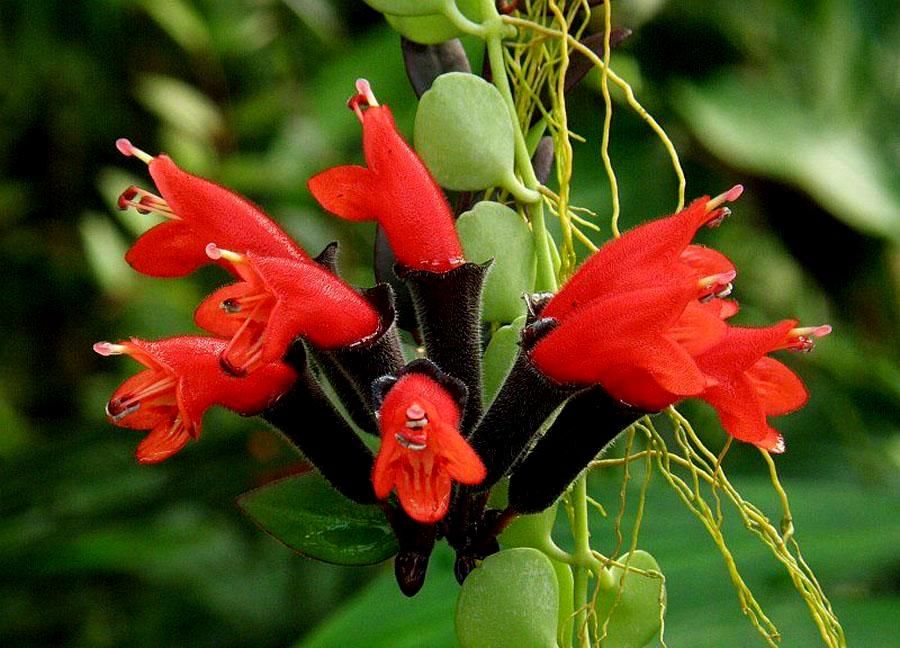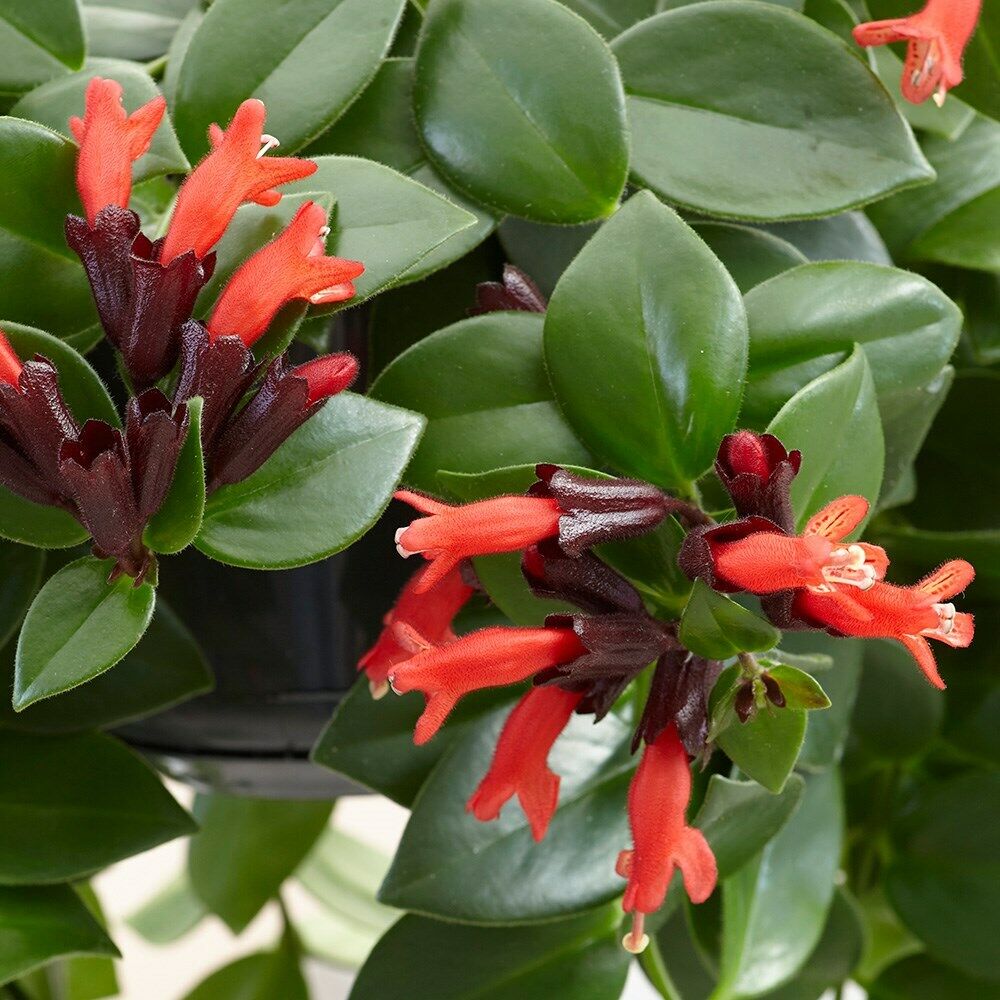Plant Overview: A Tropical Beauty in Your Home
The Lipstick Plant, scientifically known as Aeschynanthus radicans, is a captivating houseplant cherished for its unique and colorful blooms. Commonly referred to as the lipstick vine or basket vine, this evergreen perennial is a favorite for its bright red tubular flowers and lush green foliage, bringing a burst of tropical vibrancy to any indoor setting. 🌺🍃
Botanical Profile
| Botanical Profile: Lipstick Plant (Aeschynanthus radicans) | |
|---|---|
| Common Names | Lipstick Plant, Lipstick Vine, Basket Vine |
| Botanical Name | Aeschynanthus radicans |
| Family | Gesneriaceae |
| Plant Type | Evergreen Perennial |
| Mature Size | Up to 3 ft. long |
| Sun Exposure | Bright, Filtered Light |
| Soil Type | Well-drained |
| Bloom Time | Spring, Summer, Fall |
| Flower Color | Vivid Red |
| Hardiness Zones | 10a–11b (USDA), Typically Grown as a Houseplant |
| Native Area | Southeast Asia |
The Lipstick Plant, native to the humid tropics of Southeast Asia, is an epiphytic plant, meaning it often grows on other plants in its natural habitat. Its trailing vines and bright red flowers make it an ideal candidate for hanging baskets or as a decorative houseplant.

Caring for Your Lipstick Plant
Sunlight and Location
To ensure your Lipstick Plant thrives, provide it with bright, filtered light. A spot near a window that offers indirect sunlight is perfect, as direct sun can scorch the leaves. Lipstick plants need bright light to bloom but should be protected from harsh sun rays.
Watering and Humidity
- Watering: Keep the soil consistently moist during the growing season, but avoid overwatering to prevent root rot. Allow the topsoil to dry slightly between waterings.
- Humidity: These plants love high humidity. Regular misting, placing the plant on a pebble tray, or using a humidifier can help maintain the desired moisture levels in the air.
Soil and Feeding
Use a well-draining potting mix to ensure good drainage. Fertilize your Lipstick Plant with a diluted liquid fertilizer every two weeks during the spring and summer months to encourage growth and blooming.
Temperature
Maintain a warm environment for your plant, ideally between 65–75 degrees Fahrenheit. Keep it away from drafty windows and sudden temperature changes to avoid stress.
Propagation and Pruning
Pruning for Health and Shape
Pruning is essential to maintain a bushy, healthy plant. After flowering, prune back the stems to encourage new growth. This also helps prevent the plant from becoming leggy.
Propagation Techniques
Lipstick Plants are easy to propagate from soft stem cuttings. Simply cut a piece around 4-6 inches long, remove the leaves from the lower part of the cutting, and plant it in moist soil. Rooting typically takes about two weeks.
Varieties and Cultivars
Diverse and Attractive Options
Several cultivars of Aeschynanthus radicans offer a variety of leaf forms and flower colors. Popular varieties include ‘Curly’, ‘Mona Lisa’, ‘Variegata’, ‘Tangerine’, and ‘Rasta’, each boasting unique characteristics like wavy leaves, different flower colors, or variegated foliage.

Blooming Tips for a Spectacular Display
Encouraging Vibrant Blooms
For the most prolific blooming, provide your Lipstick Plant with the right balance of bright light, moisture, and fertilizer. Cooler and slightly drier conditions in the winter can help set buds for spring flowers. Remember, consistent care is key to seeing those stunning red blooms.
Expert Tips and Tricks
Growing in Different Conditions
- Outdoor Growing: While typically a houseplant, the Lipstick Plant can be moved outdoors in the summer in warmer climates but should be brought back in when temperatures drop below 60°F.
- Pests and Problems: Keep an eye out for common pests like aphids. Overwatering can lead to root rot, so ensure good drainage and avoid letting the plant sit in water.
Special Care Considerations
- Drafts and Temperature: Protect your Lipstick Plant from cold drafts and drastic temperature changes. Consistent, warm conditions are best for growth.
- Potting and Repotting: Choose a pot that allows for adequate drainage. Repot your Lipstick Plant when it becomes root-bound or refresh the soil, typically every two years.
Why Choose a Lipstick Plant?
Aesthetic Appeal and Easy Care
The Lipstick Plant is an excellent choice for indoor gardeners who want a low-maintenance yet visually striking plant. Its cascading vines and bright red tubular flowers, reminiscent of lipstick emerging from a tube, make it a lively addition to any indoor space. Plus, with its easy-care nature, it’s perfect for both novice and experienced plant enthusiasts.
Versatility in Home Decor
Whether you aim to introduce a burst of color to your living room, evoke a tropical vibe in your office, or enliven your kitchen, the Lipstick Plant is a versatile choice that adjusts well to different indoor settings. Moreover, its capacity to bloom for much of the year guarantees an ongoing display of beauty.

Frequently Asked Questions About Lipstick Plant
1. Why is it Called a Lipstick Plant?
The Lipstick Plant, or Lipstick Vine, gets its name from its unique flowers. The blooms resemble tubes of lipstick, as the bright red or orange flowers emerge from darker-colored buds, much like lipstick emerging from a tube. This distinct appearance makes it a standout among houseplants. 💄🌸
2. How Do I Care for My Lipstick Vine?
Lipstick Plant care involves a few key practices:
- Light: These tropical plants love bright, indirect light. Direct sunlight can scorch the leaves, so a spot with filtered light is ideal.
- Water: Keep the soil consistently moist but not waterlogged. Overwatering can lead to root rot, so ensure good drainage.
- Humidity: Being tropical, the Lipstick Plant thrives in humid conditions. If your home is dry, consider using a humidifier or placing the plant on a pebble tray.
- Temperature: Maintain warm and stable temperatures. Avoid placing your plant in drafty areas or near air conditioning vents.
3. What Potting Soil is Best for Lipstick Plants?
Use a well-draining potting mix designed for epiphytes or tropical plants. The Lipstick Plant prefers a slightly acidic to neutral pH. Adding perlite or orchid bark to regular potting soil can improve drainage.
4. Why Are the Leaves on My Lipstick Vine Dropping?
Leaf drop in the Lipstick Plant can be a sign of stress, often due to overwatering, under-watering, or drastic temperature changes. Examine your watering routine and the plant’s environment to determine the cause.
5. How Do I Propagate Lipstick Plants?
Propagating Lipstick Plants is relatively easy. Cut a piece of stem with a few leaves and allow it to dry for a day or so. Then, plant it in moist potting soil. Roots usually develop within a few weeks.
6. My Lipstick Plant Isn’t Blooming. What Can I Do?
If your Lipstick Plant is not blooming, it might not be getting enough light or the right care. Ensure it’s in a bright location and consider adjusting your watering and feeding practices. Cooler and drier conditions in the fall and winter can help set flower buds.
7. Are There Different Varieties of Lipstick Plants?
Yes, there are several varieties of Lipstick Plants, each with unique characteristics. The ‘Black Pagoda’ Lipstick Plant, for example, has dark green leaves with a mottled, almost black appearance. Other varieties might have variegated foliage or different flower colors.
8. Can I Grow a Lipstick Plant as a Hanging Plant?
Absolutely! Lipstick Plants, especially the trailing varieties like the ‘Black Pagoda’, are often grown as hanging plants. Their cascading vines and vibrant flowers make them an attractive addition to any indoor space.
9. How Often Should I Fertilize My Lipstick Plant?
Fertilize your Lipstick Plant during the growing season (spring to early fall) with a balanced, liquid fertilizer. Reduce feeding in the cooler months when the plant’s growth slows.
10. What Are the Ideal Conditions for Lipstick Plants to Bloom?
For the best chance of blooming, provide your Lipstick Plant with bright, indirect light and keep the soil consistently moist. Cooler temperatures and less frequent watering in the winter months can help stimulate the formation of flower buds.
11. How Do I Maintain the Dark Green Leaves of My Plant?
To maintain the rich, dark green leaves of your Lipstick Plant, provide it with adequate light and the right amount of fertilizer. Insufficient light can cause the leaves to lose their vibrancy.
12. Can Plants Grow in Low Light Conditions?
While they prefer bright light, Lipstick Plants can tolerate lower light conditions. However, they may not bloom as prolifically and their growth could slow down.
13. Is the Lipstick Plant Suitable for Beginners?
Yes, the Lipstick Plant is considered easy to care for, making it suitable for beginner gardeners. With its forgiving nature and minimal care requirements, it’s a great choice for those new to indoor gardening.
14. What Should I Do If I Notice Pests on My Plant?
Inspect your plant regularly for pests like aphids or spider mites. If you notice any, isolate the plant and treat it with an appropriate insecticide or natural remedy like neem oil.
15. Can I Grow Basket Vine Outdoors?
In warmer climates, Basket Vines can be grown outdoors in the summer. They thrive in warm and humid conditions but should be brought indoors when temperatures start to drop.

